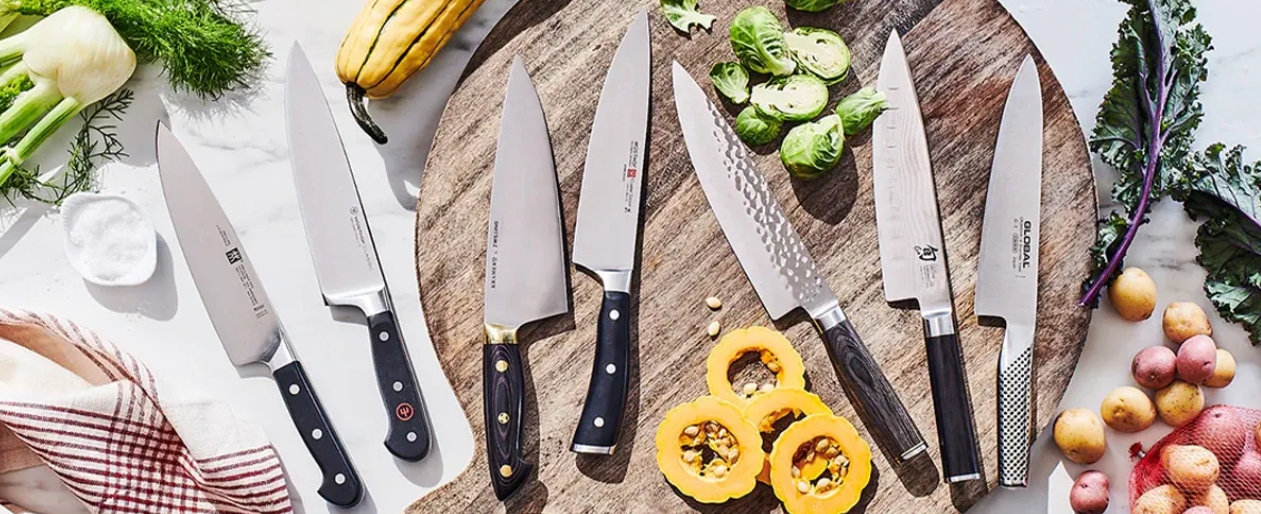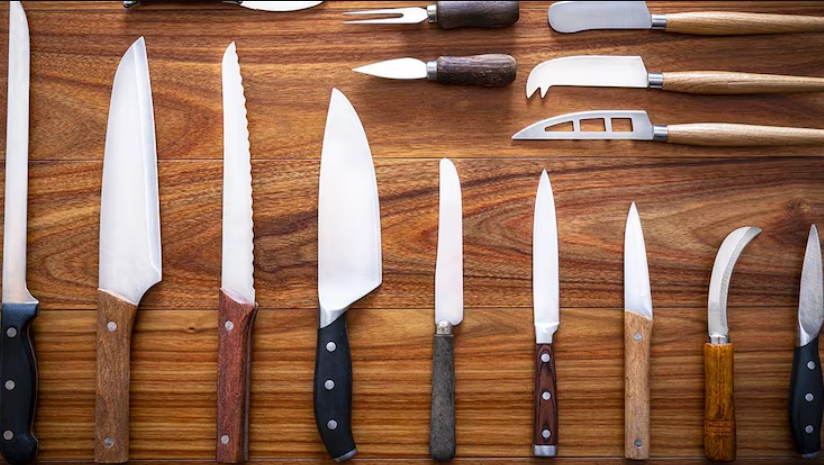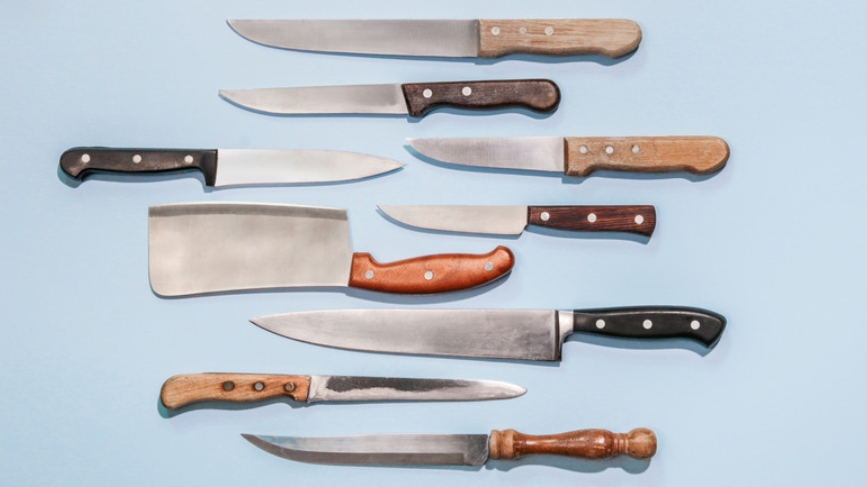

Views: 222 Author: Ella Publish Time: 2025-04-25 Origin: Site








Content Menu
● The Anatomy of a Kitchen Knife
● Blade Material and Steel Quality
>> Edge Retention and Hardness
>> Bevel Types
>> Blade Shape
● Handle Quality and Ergonomics
● Craftsmanship and Brand Reputation
● Visual and Tactile Quality Indicators
● FAQ: What Makes a Kitchen Knife High Quality?
>> 1. What type of steel is best for a kitchen knife?
>> 2. How important is the knife's balance?
>> 3. What blade shape is most versatile?
>> 4. How do I maintain a high-quality kitchen knife?
>> 5. Are handmade knives better than factory-made knives?
A kitchen knife is one of the most essential tools in any kitchen, whether for professional chefs or home cooks. But what exactly makes a kitchen knife high quality? This comprehensive guide explores the critical factors that define a superior kitchen knife, including blade materials, design, craftsmanship, maintenance, and more. Along the way, you will find helpful images and videos illustrating these concepts, culminating in a conclusion and a detailed FAQ section to answer common questions.

Before diving into quality factors, it's important to understand the basic parts of a kitchen knife:
- Blade: The cutting part of the knife, consisting of the edge, spine, tip, and belly.
- Edge: The sharpened portion that does the cutting; can be plain, serrated, or specialized.
- Spine: The thick, dull back of the blade opposite the edge.
- Tip: The pointed end used for piercing and detailed work.
- Heel: The rear part of the blade near the handle, used for heavy cutting.
- Tang: The part of the blade extending into the handle; can be full, partial, or skeletonized.
- Handle: The grip area, often designed ergonomically for comfort and control.
- Bolster: The thick junction between blade and handle, adding balance and safety.
Understanding these parts helps in evaluating quality and suitability for different tasks[8][18].
The blade material is the heart of a kitchen knife's quality. Most high-quality kitchen knives use some form of high-carbon stainless steel or tool steel. The steel's hardness is measured by the Rockwell Hardness Scale (HRC), with quality kitchen knives typically at 56 HRC or higher. Below this, knives tend to dull quickly and are harder to sharpen[1].
- High Carbon Steel: Contains over 0.8% carbon, holds a sharp edge longer, and is easier to sharpen but may develop a patina or rust if not properly cared for.
- Stainless Steel: Contains higher chromium content (over 10%) for rust resistance but often has less carbon, which can reduce edge retention.
- Laminated Steel (San Mai): Combines a hard carbon steel core with softer stainless steel outer layers. This creates a blade that is sharp, durable, and easier to maintain[1][6].
A high-quality knife maintains its sharpness longer, reducing the need for frequent sharpening. Tool steels with carbon content up to 3% and sufficient chromium offer the best edge retention but can be more challenging to sharpen[1][14].
- Double-Bevel (Western style): Ground on both sides, usually at 20-30 degrees per side, offering durability and suitability for both left- and right-handed users.
- Single-Bevel (Traditional Japanese): Ground on one side with a sharper angle (around 12-18 degrees), providing superior sharpness and precision but requiring more care and skill to maintain[1][16].
The blade shape affects versatility and cutting style:
- Chef's Knife/Gyuto: Curved belly for rocking cuts, versatile for slicing, chopping, and dicing.
- Santoku: Flatter belly, ideal for chopping and slicing with a push cut.
- Utility and Paring Knives: Smaller blades for precision tasks[18][15].
Thinner blades reduce friction and allow for precise cuts but require harder steel to maintain durability. Thicker blades are more robust but less nimble[19].

A high-quality kitchen knife features a handle that offers:
- Comfortable Grip: Ergonomically shaped to reduce hand fatigue during extended use.
- Secure Hold: Non-slip materials or textures to prevent accidents.
- Full Tang Construction: The blade extends through the handle, enhancing balance and durability[2][14].
Materials vary from wood (like carbonized rosewood) to synthetic composites, with each offering different aesthetics and maintenance needs[2].
Balance between the blade and handle is crucial for control and ease of use. A well-balanced knife feels like an extension of your hand, reducing strain and improving precision[2][3].
Knives from reputable brands such as Wüsthof, Shun, Global, Zwilling, and Takamura are often indicators of high quality due to their rigorous manufacturing standards and attention to detail[14][3].
Handmade knives, especially those forged by expert bladesmiths, exhibit superior craftsmanship and unique characteristics, often reflected in the blade's finish and edge sharpness[5][16].
A high-quality kitchen knife is designed for easy maintenance:
- Sharpening: Should be straightforward with whetstones or sharpening systems. Sharpening angles vary: Western knives at ~20°, Japanese knives at ~15°[13].
- Honing: Regular honing realigns the edge to maintain sharpness.
- Cleaning: Hand wash with warm soapy water and dry immediately to prevent rust, especially for carbon steel knives[12].
- Storage: Use knife blocks, magnetic strips, or protective sleeves to avoid damage[12].
- Smooth, flawless blade surface without rough edges.
- Seamless transition between blade and handle.
- No protruding rivets or rough spots on the handle.
- Attractive finishes such as Damascus patterns, though these are aesthetic rather than functional enhancements[1][14].
A high-quality kitchen knife is a blend of superior materials, expert craftsmanship, thoughtful design, and proper maintenance. The blade's steel composition and hardness, edge geometry, handle ergonomics, and balance all contribute to the knife's performance and longevity. Investing in a reputable brand or a well-crafted handmade knife ensures that your kitchen tool remains sharp, comfortable, and reliable for years. Proper care, including regular honing, sharpening, and safe storage, will maximize your knife's lifespan, making cooking safer and more enjoyable.

High-carbon stainless steel with a hardness of at least 56 HRC is ideal. Laminated steels with a hard core and softer outer layers offer excellent edge retention and ease of maintenance. Carbon steel holds an edge well but requires more care to prevent rust[1][6].
Balance is crucial for control and comfort. A well-balanced knife feels like an extension of your hand, reducing fatigue and increasing precision during cutting tasks[2][3].
The chef's knife or Japanese Gyuto, with a curved belly and pointed tip, is the most versatile, suitable for slicing, chopping, dicing, and mincing[15][18].
Wash by hand with warm soapy water immediately after use, dry thoroughly, hone regularly to realign the edge, and sharpen a few times a year depending on use. Store safely to avoid damage[12][13].
Handmade knives often exhibit superior craftsmanship, unique aesthetics, and can offer exceptional sharpness and edge retention. However, high-quality factory knives from reputable brands also provide excellent performance and durability[5][16][14].
[1] https://sharpedgeshop.com/blogs/knives-101/how-to-choose-a-kitchen-knife
[2] https://www.thecookingguild.com/blogs/news/top-qualities-of-a-good-cooking-knife
[3] https://www.olivemagazine.com/reviews/best-chefs-knives/
[4] https://www.gettyimages.co.uk/photos/kitchen-knife
[5] https://www.youtube.com/watch?v=k383zFSergs
[6] https://www.youtube.com/watch?v=m2CeQI-5aeA
[7] https://www.youtube.com/watch?v=bYZBEMSWpZ8
[8] https://knifesharp.co.uk/blogs/the-sharp-blog/anatomy-of-a-kitchen-knife
[9] https://elementknife.com/pages/common-questions-about-kitchen-knives
[10] https://circulon.uk.com/blogs/the-culinary-circle/what-you-need-to-know-when-buying-kitchen-knives
[11] https://www.knivesandtools.co.uk/en/ct/buying-guide-knife-sets.htm
[12] https://www.souschef.co.uk/blogs/the-bureau-of-taste/how-to-care-for-your-kitchen-knife
[13] https://www.souschef.co.uk/blogs/the-bureau-of-taste/how-to-sharpen-your-kitchen-knives
[14] https://salamanderstoves.com/how-can-you-tell-if-a-kitchen-knife-is-well-made/
[15] https://japaneseknifecompany.com/product-category/knives/knife-shapes/gyuto/
[16] https://www.youtube.com/watch?v=bkDEkUlo5u8
[17] https://www.nytimes.com/wirecutter/reviews/the-best-chefs-knife-for-most-cooks/
[18] https://knife-depot.com/pages/the-complete-guide-to-buying-kitchen-knives
[19] https://www.knivesandtools.co.uk/en/ct/information-about-kitchen-knives.htm
[20] https://www.lakeland.co.uk/info/knife-guide
[21] https://www.reddit.com/r/cookingforbeginners/comments/f7shfw/factors_to_look_our_for_when_finding_a_good_knife/
[22] https://www.williamhenry.com/wh-insider/main-qualities-of-kitchen-knives/
[23] https://www.goodhousekeeping.com/uk/product-reviews/house-garden/g32205000/best-kitchen-knives/
[24] https://dfackto.com/blogs/news/which-material-works-best-for-kitchen-knives
[25] https://gentrychoiceusa.com/blogs/blogs/exploring-the-world-of-handmade-chef-knives-and-kitchen-knives
[26] https://www.thespruceeats.com/best-japanese-knives-4178850
[27] https://www.seriouseats.com/the-best-chefs-knives
[28] https://heinnie.com/blog/premium-kitchen-knives-vs-standard-kitchen-knife-sets/
[29] https://www.thecookingguild.com/blogs/news/best-chef-knives
[30] https://sharpknife.org/unveiling-the-craftsmanship-japanese-kitchen-knives/
[31] https://www.foodandwine.com/lifestyle/kitchen/best-chefs-knife
[32] https://www.kitchenkapers.com/pages/how-to-choose-kitchen-knives
[33] https://www.istockphoto.com/photos/kitchen-knife
[34] https://stock.adobe.com/search?k=chef+knife
[35] https://www.istockphoto.com/photos/chef-knife
[36] https://www.youtube.com/watch?v=GsCNJy281SQ
[37] https://sharpedgeshop.com/blogs/knives-101/how-to-choose-a-kitchen-knife
[38] https://orientknives.com/blogs/news/parts-of-a-knife
[39] https://www.wusthof.co.uk/collections/all-purpose-knives/chefs-knives
[40] https://craftsmanship.net/video/bob-kramers-essential-line/
[41] https://www.youtube.com/watch?v=Hgti2oAhDsU
[42] https://www.youtube.com/watch?v=JFhkPlTj-O8
[43] https://rydaknives.com.au/blogs/news/top-10-features-to-look-for-in-a-quality-kitchen-knife
[44] https://www.shutterstock.com/search/kitchen-knife
[45] https://www.souschef.co.uk/blogs/the-bureau-of-taste/the-complete-guide-to-kitchen-knives
[46] https://aolcookshop.co.uk/pages/kitchen-knife-buying-guide
[47] https://theknifestore.co.uk/pages/frequently-asked-questions-about-knives
[48] https://www.seriouseats.com/the-best-essential-knives
[49] https://northernknife.com/blogs/blogs/the-essential-guide-to-maintaining-your-knife
[50] https://www.keithnixknives.com/knife-sharpening-questions-and-answers
[51] https://www.blackmoorhome.co.uk/blog/a-guide-to-different-types-of-kitchen-knives/
[52] https://www.divertimenti.co.uk/blogs/the-cookery-edit/common-knife-questions
[53] https://www.knivesandtools.co.uk/en/ct/buying-guide-what-do-you-want-to-cut-kitchen-knives.htm
[54] https://smithsproducts.co.uk/blogs/blog/a-guide-to-knife-care-when-a-knife-needs-to-be-cleaned-and-sanitized
[55] https://www.kitchenprovisions.co.uk/pages/knife-sharpening-faqs
[56] https://artisanrevere.com/blogs/education/knife-faq-and-problem-solving
[57] https://millyskitchenstore.co.uk/blogs/news/what-are-the-best-steels-for-kitchen-knives
[58] https://www.blackdragonforge.com/blogs/knifemaking/the-rise-of-handmade-kitchen-knives-meeting-the-demand-for-high-quality-culinary-tools